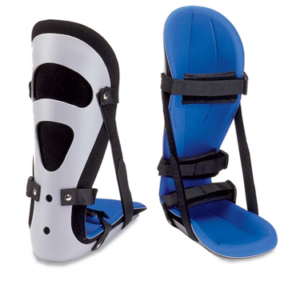Microprocessor vs. Non-Microprocessor Prosthetic Feet
One of the important features of a prosthesis for lower limb amputees is the prosthetic foot. There are many different models of feet by several companies, such as Otto Bock, Ossur, Endolite, Freedom Innovation and College Park. As the prosthetist knows, choosing the right prosthetic foot is very important for the patient. The foot can help the patient perform specific tasks, such as running, or just help with every day walking. As the field of Prosthetics has evolved, so has the feet. There are now feet made of carbon fiber, instead of wood and rubber, and even microprocessor (MCP) feet. These feet use computers and programing to assist with walking to make the patient’s gait feel more natural. With the release of the MCP, the following question now comes to mind- is a MCP foot right for me? Here, we will discuss and compare the features of a MCP prosthetic foot to a static carbon fiber prosthetic foot.
Microprocessor feet
There are distinct advantages of choosing a MCP foot over a static carbon fiber prosthetic foot. MCP feet have a hydraulic ankle that is controlled through computers and programming. The MCP foot will allow the patient to feel the advantages on a level ground. This hydraulic ankle helps mimic the three rockers of the stance phase over level ground. This requires a rapid foot flat, while maintaining balance/stability for weight acceptance. For the second rocker, the MCP provides articulation at the ankle. This gives the patient a more natural tibial progression through the second rocker. Resistance of the ankle is controlled by the MCP to adapt ankle stiffness to changes in the patient’s walking speed. During the third rocker, the MCP modulates ankle stiffness to gradually provide a transition from ankle dorsiflexion to deflection of keel during tibial progression. This all allows the patient to get a more natural gait, and not have those “dead spots” often felt in static carbon fiber feet. (Kaluf, B. & Smith, C.,, 2018; Agrawal, V. et al., 2013)
The MCP foot also has distinct advantages on stairs and ramps. While ascending stairs, the MCP foot is able to dorsiflex to allow adequate toe clearance. This helps prevent stumbling and catching the foot on the stair. In a study by Agrawal at el. (2013), a MCP foot showed to have a significant improvement in symmetry while ascending stairs as compared to carbon fiber feet and a SACH foot. The MCP foot also helps control how fast tibial progression occurs on a ramp. By increasing the dorsiflexion resistance while descending a ramp, the tibial progression velocity was significantly slower when compared to elastic feet and carbon fiber feet in a study by Struchkov & Buckley (2015). This reduced tibial progression gave the patient more control and reduced amount of knee flexion. This made the MCP foot safer than other feet while descending ramps. Just like any other device on the market, while MCP feet come with their distinct advantages, they also come with their disadvantages. MCP are generally heavier than static carbon fiber feet. MCP feet generally weight between 749-1488 grams, which is about two times heavier than the standard carbon fiber foot. Sometimes, the improved function of the MCP is not enough for the patient to not notice the weight. This can cause discomfort to the patient or lack of prosthetic use. Another disadvantage is the cost of a MCP foot. MCP cost two to three times more than a static carbon fiber foot. Not all insurance companies cover MCP feet, so there may be a large out of pocket cost. Lastly, due to the high number of mechanical and electronic parts, these feet are more susceptible to accidental damages and normal wear. This will require necessary routine maintenance to be performed. MCP feet are not recommended for use in a wet environment due to the electronic failures that could occur when water comes in contact with the foot.
Static Carbon Fiber Feet
A different option for prosthetic feet is static carbon fiber feet. These feet have a fixed ankle, and not an articulating one like a MCP. These feet are more common. Carbon fiber feet fall into different sub categories such as dynamic response, multi-axial, and multi-axial dynamic response. There are a multitude of carbon fiber feet on the market. Each foot has their own features that make is beneficial for a specific amputee population, such as multi-axial dynamic response feet for individuals that do a lot of hiking and walking on uneven terrain.
There are advantages to using a static carbon fiber foot when compared to a MCP foot. For the dynamic response and multi-axial feet, they help store energy and return it during propulsion during gait. While the patient is starting to progress their tibia and move into dorsiflexion during the stance phase, the energy starts to store in the keel of the foot. Then when the patient progresses to push off, the energy is used to help propel the patient and move the limb forward. This is a feature that MCP feet and non- MCP single axis/hydraulic feet don’t have as they have an articulating ankle, and don’t load the keel to store as much energy for propulsion. This is why the static carbon fiber feet are typically used for more active amputees. Static carbon fiber feet have several other beneficial features. These feet tend to be lighter weight, which is appealing to many patients. They have shock absorbing features that make these feet appealing to amputees, as it helps take pressure absorbed by the residual limb to allow the patient to walk longer and further. Due the design of the feet, there are fewer mechanical parts. This helps reduce the need for routine maintenance and failures by the device. These feet are able to get wet without failing, but it is still recommended that post of these feet do not go into salt water. These prosthetic feet are also easier to get coverage for by insurance as they do not have any microprocessor parts, which some insurances exclude from their coverage.
While the static carbon fiber prosthetic feet have their advantages, they also have their disadvantages. Static feet might make it hard for some patients to ascend stairs. The patient might not have enough strength or range of motion to lift their foot high enough to not catch the toe. Due to the lack of dorsiflexion in these feet, it is common for the patient to catch their toe. This increases their fall risk and the need for medical attention. Static carbon fiber feet also can cause excessive pressures on the residual limb when descending. Since there is no ankle, these feet will lack proper dorsiflexion while the tibia progresses over the foot while descending the stairs. This will cause extension at the knee when the patient should be flexing the knee to progress her limb. In the study by Agrawal et al. (2013), a static carbon fiber foot has significantly lower symmetry in gait when ascending/descending stairs when compared to a MCP foot. This causes the patient to require more work to achieve balance and stability on the stairs. On uneven ground and hills/slopes, a static carbon fiber foot doesn’t allow the same tibial progression as a MCP foot. This can cause uneven gait and loss of stability. For inclines and declines, a lot of patients with static carbon fiber feet will not be able to traverse going straight up or down. They will need to ascend/descend at an angle as there is not articulating ankle to properly meet the ground after initial contact. This can cause excessive socket pressure which can lead to discomfort and pain in the residual limb.
In conclusion, knowing the advantages and disadvantages to MCP feet and static carbon fiber feet is not only important for the prosthetist, but their patient as well. The MCP foot shows significant benefits with having an articulating ankle to help the foot get to slap quicker while walking and to help produce a more natural gait. The downsides include weight, cost, and routine maintenance. The static carbon fiber feet show promise in having more energy return during propulsion, while being lighter and not requiring routine maintenance. They do fall short on traversing uneven terrain, hills and stairs due ot their lack to be able to mimic an articulating ankle. These can understanding can provide much needed insight to ensure the success of any amputee.
References
Agrawal, V., Gailey, R., Gaunard, I., O’Toole, C., & Finnieston, A. Comparison between microprocessor-controlled ankle/foot and convential prosthetic feet during stair negotiation in people with unilateral transtibial amputation. Journal of Rehabilitation & Research Development. 2013; 50 (7): 941-950.
Kaluf, B. & Smith, C. Advantages and Disadvantages of Microprocessor-Controlled Prosthetic Ankles. O&P News. August 2018.
Struchkov, V. & Buckley, J. Biomechanics of ramp descent in unilateral trans-tibial amputees: Comparison of a microprocessor controlled foot with convential ankle-foot mechanisms. Clinical Biomechanics. 2016; 32: 164-170.





